Businesses across industries are migrating their workloads to the cloud for efficiency and enhanced performance. One of the fastest and most inexpensive ways to migrate to the cloud is to take your workload as-is and operate it on cloud-native resources. This is known as the lift and shift cloud migration strategy. It promises speed, scalability, agility, less effort, and cost savings compared to other cloud migration strategies.
According to research[1] moving more workloads to the cloud is among the top cloud-related priorities for enterprises adopting digital transformation. This blog will explore the essentials of the lift and shift strategy when it makes the most sense, its business benefits, and practical use cases. We’ll also take a deeper look at how the lift and shift cloud migration approach fares against other methods and how Rishabh Software can help you transition to the cloud seamlessly.
What is Lift and Shift Cloud Migration Approach?
The lift and shift approach is popularly known as rehosting. It is the process of migrating apps or workloads (containerized apps, VMware workloads, and apps built on microservices architecture) as-is with its operating system and data store from an on-premises IT infrastructure to a public or private cloud. It offers multiple benefits, such as greater scalability, resilience, cost savings, and security.
This cloud migration approach does not require any application architecture modification or changes in the app code. The strategy enables a faster, more efficient, less expensive, and less resource-intensive migration process compared to other approaches.
What are the Business Drivers of Cloud Migration?
Businesses undergoing digital transformation are looking for ways to adapt, evolve and modernize their application infrastructure with market-leading cloud platforms like Azure and AWS. The key factors that drive most cloud migration initiatives are as under:
- The need for hybrid architecture to capitalize on services that cannot be leveraged with an on-premises setup.
- The shifting focus from underlying platforms and infrastructure to application modernization and innovation.
- The unmatched agility, availability, and scalability of on-premises deployments as opposed to cloud resources.
- The on-demand usage pattern and flexible pay-as-you-go model offered by cloud platforms help businesses convert their huge CapEx (capital expense) to a small, manageable chunk of OpEx (operational expense).
- Robust security and compliance management.
- Better alternatives to replace end-of-life software and hardware.
The lift and shift strategy provides an optimal solution to businesses that want to quickly migrate their existing applications to the cloud platform without having to do any extensive refactoring or re-architecture. But is it suitable for every scenario? Let’s find out!
When Does the Lift and Shift Migration Strategy Make Sense?
A lift and shift migration approach is ideal for businesses that want to host their workloads on the cloud and accelerate the transition journey from on-premise to cloud. This strategy is your best option when:
You’ve Got a Tight Schedule
Whether you need to fast-track migration for immediate gains in scalability or your existing hardware is nearing the end of service life, this approach saves much of your time and money. No need to revamp your applications – simply replicate them in the cloud and experience the benefits without the exhaustive cloud know-how.
Your Resources are Limited
When you’re on a tight budget, lift and shift is the most inexpensive approach to migrate to the cloud. You can reduce human effort and expenses while unlocking cloud platforms’ full potential by migrating your applications as-is, without code changes or architectural overhauls.
You’re Not Ready for a Total Cloud-native Transformation
Lift and shift can be your short-term ticket to the cloud-first world, where you enjoy immediate benefits while simultaneously optimizing applications for future-proof cloud-native architecture.
You’re Dealing with Legacy Applications
When your legacy apps become outdated and have inherent constraints to re-engineer, it is wise to move them as-is to a cloud infrastructure. Think of it as a virtual-to-cloud transformation that retains the essence of your legacy setup while unlocking the cloud’s auto-scaling and pay-per-consumption advantages –a win-win!
If you’re looking for a quick, cost-effective, and flexible cloud migration approach, lift and shift is your go-to strategy for a seamless migration that saves you time and resources. And if you want to learn about other alternatives, here’s an insightful blog on the 6R’s of cloud migration strategy with a practical explanation of when to consider which option.
Lift and Shift Migration Steps for a Successful Transition to the Cloud
You can follow this tried-and-tested lift and shift migration process for a swift, seamless, and efficient transition to the cloud. It will also help you maintain your apps’ and data’s integrity and functionality. Check out the essential steps involved in successful cloud migration to make the most out of your cloud journey.
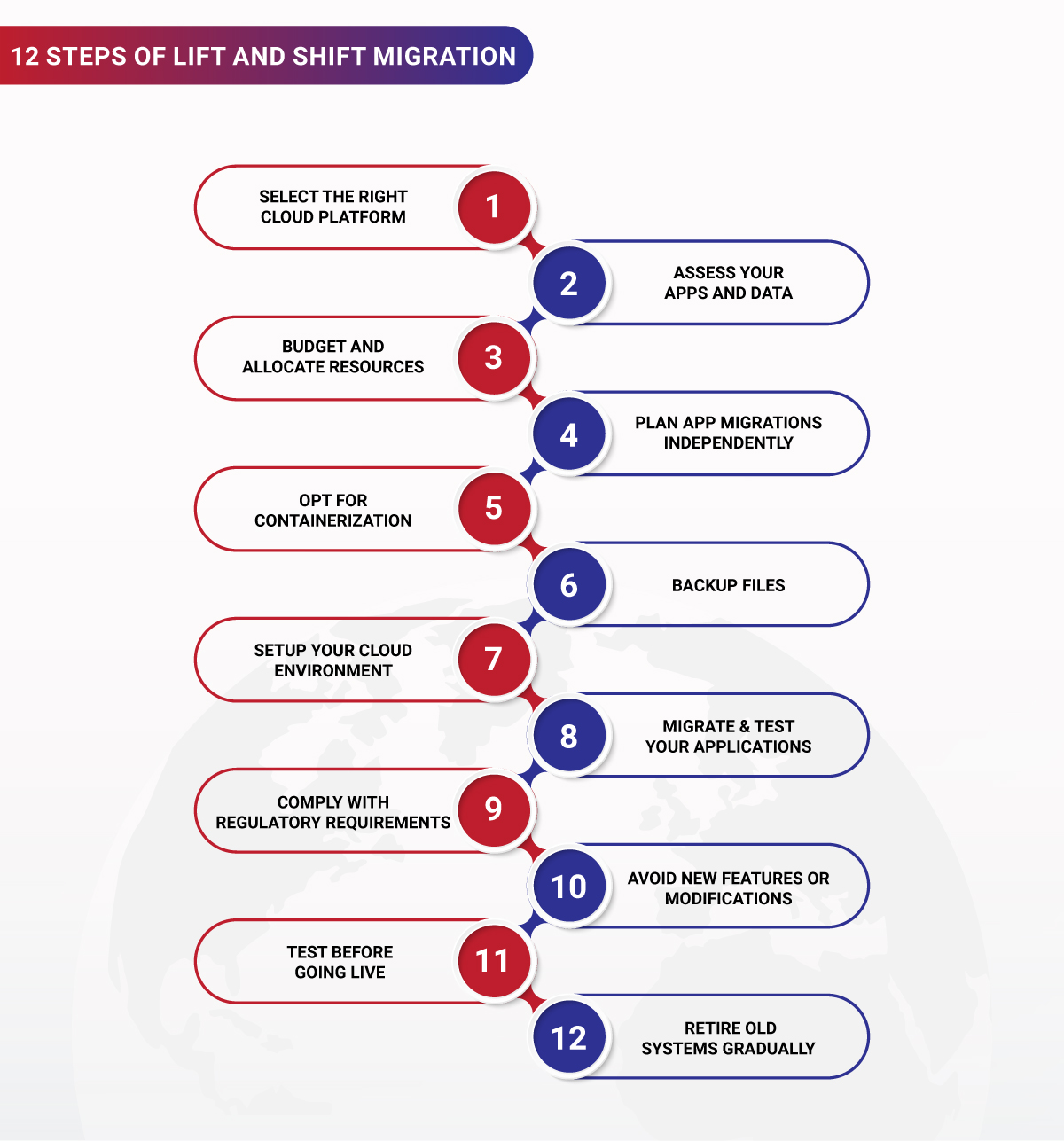
Select the Right Cloud Platform
Evaluate the cloud platform that aligns with your business needs and goals. Conduct an assessment of cloud platforms and consider scalability, cost, and compatibility factors. Refer to our comprehensive comparison between AWS and Azure to determine which makes the most sense for your business.
Assess Your Apps and Data
Identify the apps and related data you want to migrate to the cloud. List out all their dependencies and resource requirements that will be needed.
Budget and Resource Allocation
Allocate the necessary tools, budget, and team resources for a swift and seamless migration.
Plan App Migrations Independently
If you plan to lift and shift multiple applications, it is best to independently plan, document and implement each migration. You can also engage an external service provider if you wish to automate the migration roadmap for faster time to market.
Opt for Containerization
Containerization makes it easy for you to capture software systems and their dependencies. It allows hassle-free replication and testing in the cloud environment. This step is also necessary to ensure the software functions as expected before you go live.
Backup Files
Before you start the lift and shift migration, protecting the data in your existing systems is essential. You need to back up the app code, binaries, databases, and file data. Clearly defining your roll-back strategies and thoroughly testing the restore process will make managing failures easy and avoid downtime.
Setup Your Cloud Environment
The next step involves creating a cloud account, VPCs, VMs, role-based access controls, and security policies. Do follow the best practices suggested by your cloud provider and industry experts. You may also engage an experienced cloud migration company for external assistance.
Migrate & Test Your Applications
Test your migration carefully during the pre-planned maintenance window and after the application and data have been transferred. These standard validation checks on the recently shifted application will help you quickly identify and address any underlying compatibility or performance issues.
Comply with Regulatory Requirements
Monitor the underlying infrastructure and resource consumption once the app is up and running. Monitor the app for functionality, efficiency, and resource consumption. This helps ensure strict adherence to regulatory requirements, which will help you avoid legal and compliance issues after moving your apps and data to a cloud platform.
Avoid Adding New Features or Making Changes
Don’t modify or add new application features while the migration process is still on. Stay focused on maintaining the existing functionality of your apps to minimize the chances of complications or extra testing efforts.
Test Before Going Live
Testing helps verify your apps and services’ performance, functionality, and optimal resource consumption. You can use cloud dashboards for reviewing log files and infrastructure resources and make informed decisions regarding necessary optimizations.
Retire Old Systems
Once the migrated apps are running as expected in the new cloud environment, you can gradually retire your old systems. Doing this will ensure a smooth transition with uninterrupted business continuity.
Check out this quick cloud migration checklist to ensure you’re not missing any crucial detail.
Benefits of Lift and Shift Cloud Migration Process
Compared to running your apps on-premises, adopting the lift and shift cloud migration approach offers the following compelling benefits:
A Swift & Cost-Effective Migration That’s Minimally Disruptive
The lift and shift cloud strategy lets you migrate quickly and easily without allocating a dedicated team. Your on-premises apps can continue to run while the migration is in progress, so there’s no downtime, and the end-user experience also remains unaffected.
Scope for Enhanced Performance
Lift and shift cloud migration allows your business to run apps on updated, high-performing hardware without needing you to invest in the hardware yourself.
Extensibility
You can add network bandwidth, compute capacity, and storage on a flexible pay-as-you-go plan while simultaneously consolidating your on-premises setup and data center costs.
On-demand Scalability
Opting for the lift and shift migration approach allows you to scale your apps without buying and installing new computing resources. You also don’t end up overprovisioning hardware to handle traffic spikes.
Cost Savings with Cloud Elasticity
Apps running in the cloud can automatically spin resources up and down to keep up with the sudden peaks and dips in demand. So, you can save significantly by leveraging this agility of the cloud, as your apps will use just the right number of resources as and when needed.
Robust Security
Once moved to the cloud, even legacy apps can leverage the security features of cloud platforms like multifactor authentication, role-based access control, and centralized hybrid security processes.
Reduced On-premises Data Centre Costs
The more apps and data you move to the cloud, the faster you can downsize your on-premises setup and, with it, the costs, and hassles of managing and maintaining it!
An Agile Hybrid Approach
The lift and shift migration strategy allows you to move only those apps that are best suited to a public cloud platform while you continue to host other apps and workloads on-premises. With the right tools, you can efficiently manage your on-premises infrastructure and the cloud platform as a unified environment optimized for performance.
Use Cases of Lift and Shift Cloud Migration Approach
Lift and shift strategy is considered as an optimal approach for migrating cloud-ready containerized apps, VMware workloads, and applications built on microservices architecture. It allows you to leverage the cloud for its elastic computing power, potential performance benefits, and near-unlimited storage space. Below are a few common scenarios where applying the lift and shift migration approach makes the most sense:
- The costs of your on-premises setup are skyrocketing, and you do not consider it feasible to rearchitect your apps. In this case, park your applications on the cloud until you’re ready.
- You want to move your cookie-cutter apps as-is to the cloud. Moving them to the cloud is a good alternative because you cannot rearchitect the off-the-shelf apps that you’ve sourced from third-party vendors.
- You need a scalable and less costly data recovery solution with backup. Lift and shift are the most used strategy for moving backups from on-premises to public cloud platforms, even in the most heavily regulated industries.
- Your legacy apps can neither be refactored nor re-platformed, but they can perform efficiently when hosted in the cloud.
- You want to migrate your VM workloads and mission-critical apps to the cloud using the lift and shift strategy, as setting up cloud-native VMs from scratch is relatively complex and time-consuming.
- Your organization is still testing the waters with cloud adoption, and the lift and shift approach offers a simple, swift, and proven solution for your initial migration.
- You want to retain your existing on-premises infrastructure for mission-critical workloads but also want to start leveraging the cloud. In this case, you can easily use the lift and shift strategy to kick-start a hybrid cloud deployment.
The architecting and coding modifications needed for refactoring and re-platforming apps are costly and disruptive for ongoing operations. So, if you want to migrate several ups to the cloud quickly, adopting the lift and shift approach can get your apps up and running sooner without burning a hole in your budget.
Lift and Shift Cloud Strategy Vs. Other Migration Methods
Here’s a quick comparison between the lift and shift cloud migration strategy and other migration methods – PaaS and SaaS.
Lift and Shift vs SaaS Comparison
| Lift and Shift | SaaS Migration | |
| Scope | The complete app stack is moved onto the cloud, including the app architecture, code, integrations, platform, and databases. | A particular service is migrated to a cloud-based SaaS provider. |
| Control | You will have complete control over managing and maintaining your apps and workloads. | Your business relies on the SaaS provider to manage and maintain migrated apps. |
| Customizability | You can customize your infrastructure and apps to meet your unique needs. | With SaaS migration, you are restricted by the limited customization capabilities offered by the SaaS provider. |
| Deployment Time | Quicker and easier to deploy apps, data, and workloads | SaaS migration takes relatively longer to deploy as you will be required to customize and adapt the SaaS solution to align with your technical and business needs. |
| Cost | Lift and shift migration is cost-effective as you already have invested in on-premises infrastructure and hardware. | It is an economical alternative as you won’t be required to invest in an on-premises setup. Pay for the services you leverage on a monthly or yearly subscription model. |
| Maintenance | You will be responsible for managing and maintaining your cloud-based infrastructure. | The SaaS provider takes over the management and maintenance of the migrated apps. It reduces your overall workload. |
Lift and Shift vs PaaS Comparison
| Lift and Shift | PaaS Migration | |
| Migration Complexity | Easy to migrate as apps and infrastructure need little to no changes | PaaS migrations need additional rearchitecting or refactoring efforts to ensure the migrated apps and workloads fit the new PaaS environment. |
| App Management | You will be responsible for managing the infrastructure, apps, integrations, and middleware. | The cloud provider manages and maintains middleware, infrastructure, and platform services. |
| Service Flexibility | You can leverage the services available you’re your chosen cloud platform, but you will be required to configure these services. | PaaS offers more scalability and agility with a preconfigured platform. It provides a range of services like databases and caching, which can be integrated into applications. |
| Cost | A cost-effective approach as it involves minimal changes and does not need extensive re-architecting efforts. | PaaS migrations are relatively more expensive due to the extra efforts needed for re-architecting and managing services and platforms. |
| Time to Market | Faster to implement as it requires fewer changes. | Takes a longer time due to the additional efforts needed for configuring, re-architecting, managing, and maintaining the apps and services. |
To conclude, lift and shift cloud migration is a cost-effective solution for migrating existing apps and infrastructure to the cloud. If you do not want to manage it by yourself and looking for a vendor to reduce your maintenance burden, then it is advisable to go for SaaS migration. PaaS’s high scalability and flexibility come with extra efforts for rearchitecting, managing, and troubleshooting your apps and platform services.
How Rishabh Can Help You Make the Most of Your Lift and Shift Cloud Strategy
Considering a cloud migration but hesitant due to concerns about losing the data management capabilities you enjoy on-premises? At Rishabh Software, we understand businesses’ challenges when transitioning to the cloud. We are here to guide you and address these concerns head-on with our cloud consulting services.
As a certified service partner for Microsoft Azure and AWS, we will help you navigate all the challenges with a comprehensive assessment and planning of your lift and shift cloud migration.
- App Lifecycle: Will you need your existing apps or workloads in the long run? We would not recommend a migration if you need to retire an app or workload in the coming 12 months.
- API Access: We will ensure that your move to the cloud does not result in API bottlenecks and that your current API tools are seamlessly integrated with your new cloud platform.
- Road Mapping: If you want to migrate multiple apps, we will help you prioritize with a strategic plan. Our team will ensure that your mission-critical applications take precedence and move swiftly.
- Compliance Check: With us, you can rest assured that your migration plan will adhere to all compliance requirements during and after the process.
- Integrations: Cloud environments are feature-rich and may tempt you to integrate new capabilities instantly. But with us by your side, we will help you stick to a clearly defined project scope throughout the cloud migration process.
Success Story: Legacy Application Modernization For A Medical Supply Provider
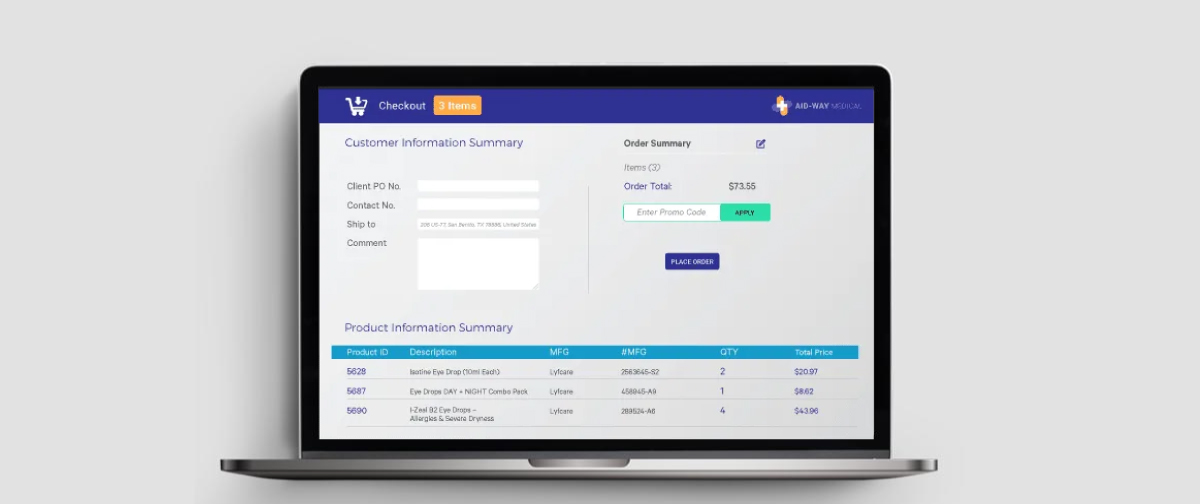
Our client, a US-based B2B ePharmacy, was struggling to keep up with the surging demand for medical supplies, a massive customer base, and a website grappling with inefficient integrations. Their current setup was rooted in legacy ASP and lacked user-friendliness, hindering their growth and new opportunities.
Our Solution
We initiated a complete overhaul leveraging the full potential of ASP.NET with MVC architecture to build an interactive web app. Our team implemented the lift and shift approach to move their legacy servers onto Microsoft Azure. This lifting and shifting helped the client to unlock their true business value with excellent speed, robust security, and automated processes.
Key Benefits Delivered
- A 47% surge in conversion rates
- System performance skyrocketed by 5 times
- Streamlined navigation and a sleek user interface enhanced the user experience.
- A centralized workflow system accelerates critical processes
Learn more about how we modernize legacy pharmacy application with cloud to help our client digitally transform their ePharmacy and tap into lucrative opportunities.
Conclusion
The Lift-and-Shift method has emerged as a user-friendly, reliable, and secure rehosting solution. Its ease of implementation allows businesses to enhance data management efficiency and gain a competitive edge. Don’t let apprehensions hold you back. Now is the time to embrace the cloud, and with Rishabh Software as your cloud app development services partner, you won’t just make a move – you’ll take a leap toward innovation, efficiency, and growth. Let’s team up and unlock the full potential of your cloud migration strategy.
FAQs
Q. Lift and shift vs. modernization, what is the difference between the two?
A. Lift and shift migration is an approach where you lift all the databases, applications, and processes from your on-premises servers and shift them to the cloud without making any major changes to any of your databases, apps, or processes. Some applications can be moved as is, and some may need minor adjustments before they’re migrated.
On the other hand, modernization requires changing the data of how it is sorted to improve your application’s performance, efficiency, and security.
The choice between lift and shift and modernization depends on your company’s specific needs and goals. Lift and shift is a simpler and faster approach, while modernization can offer more long-term benefits but may require more upfront investment.
Q. Can you list popular real-world lift and shift migration examples?
A. Many known businesses have used the cloud migration strategy lift and shift to move to the cloud to unlock its scalability, flexibility, efficiency, and massive cost savings. Listed below are just a few of many stories of successful cloud migrations that changed the game for these giants:
- In 2008, Netflix faced a data center hiccup that halted its DVD sales for days. Recognizing the limits of its monolithic setup, Netflix chose a better route. By embracing the cloud[2], it digitized workflows for enhanced agility and resilience. Today, Netflix’s cloud-native architecture thrives on AWS. Features like autoscaling and microservices are driving its streaming success.
- GE Oil and Gas set an ambitious goal of migrating 500 applications to AWS by the end of 2016. They needed swift action to shed their legacy processes and slice IT costs. Adopting the lift and shift strategy, they quickly migrated 750 terabytes of data, saving a jaw-dropping 52%.
- News Corp took the lift and shift route to move 75% of their applications to the cloud, shrinking their data centers from 56 to just 6 and saving $100 million in operational overheads.
Q. What are the best practices for lift and shift migration?
A. Here’s how you can ensure a smooth transition to the cloud using the lift and shift method:
- Choose an appropriate cloud architecture.
- Secure your data through backups.
- Restore backups into the new cloud environment.
- Simplify your current physical systems for efficient replication.
- Ensure system stability and software compatibility for a smooth transition.
- Monitor and test performance over a period of at least two months.
As an experienced cloud expert, we have in-depth knowledge and extensive experience implementing cloud migrations across industries. Whether you need assistance to take your legacy apps to the cloud or want to move your enterprise apps between cloud platforms, we’re here to help!
Footnotes:
1. https://info.flexera.com/CM-REPORT-State-of-the-Cloud
2. https://aws.amazon.com/solutions/case-studies/netflix-case-study/
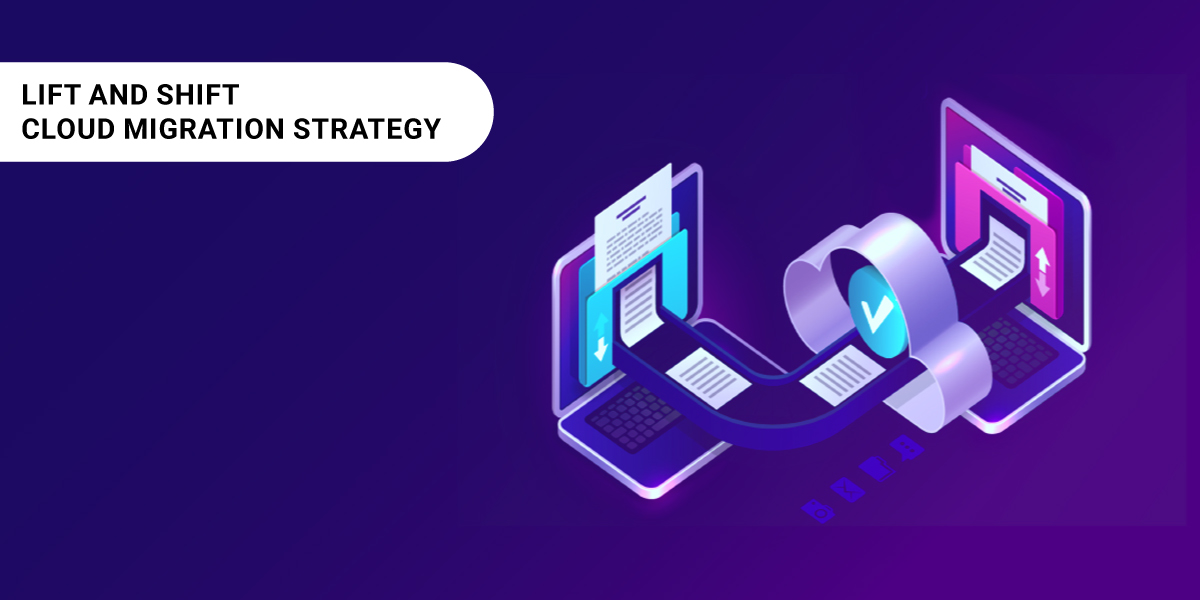

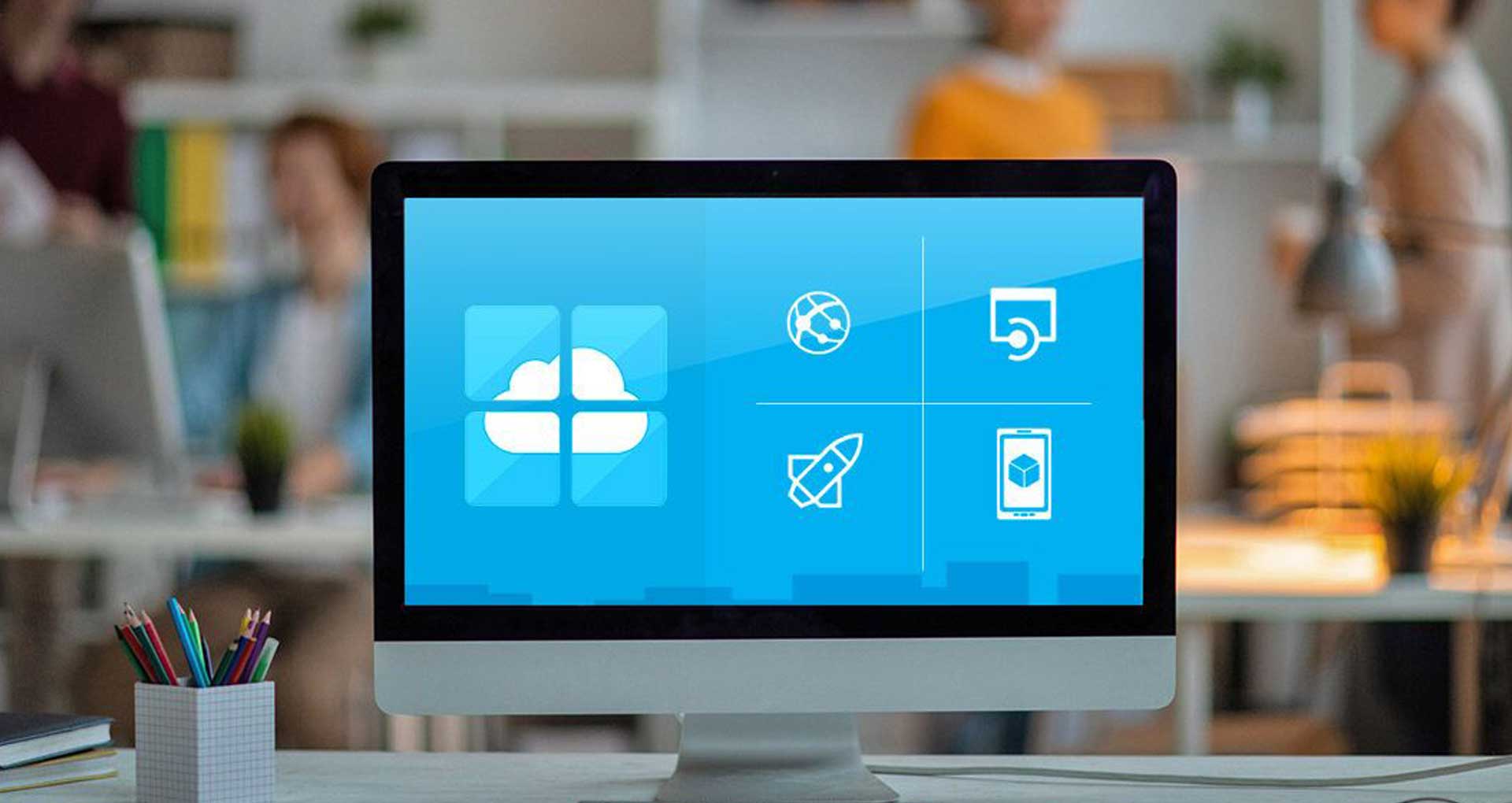
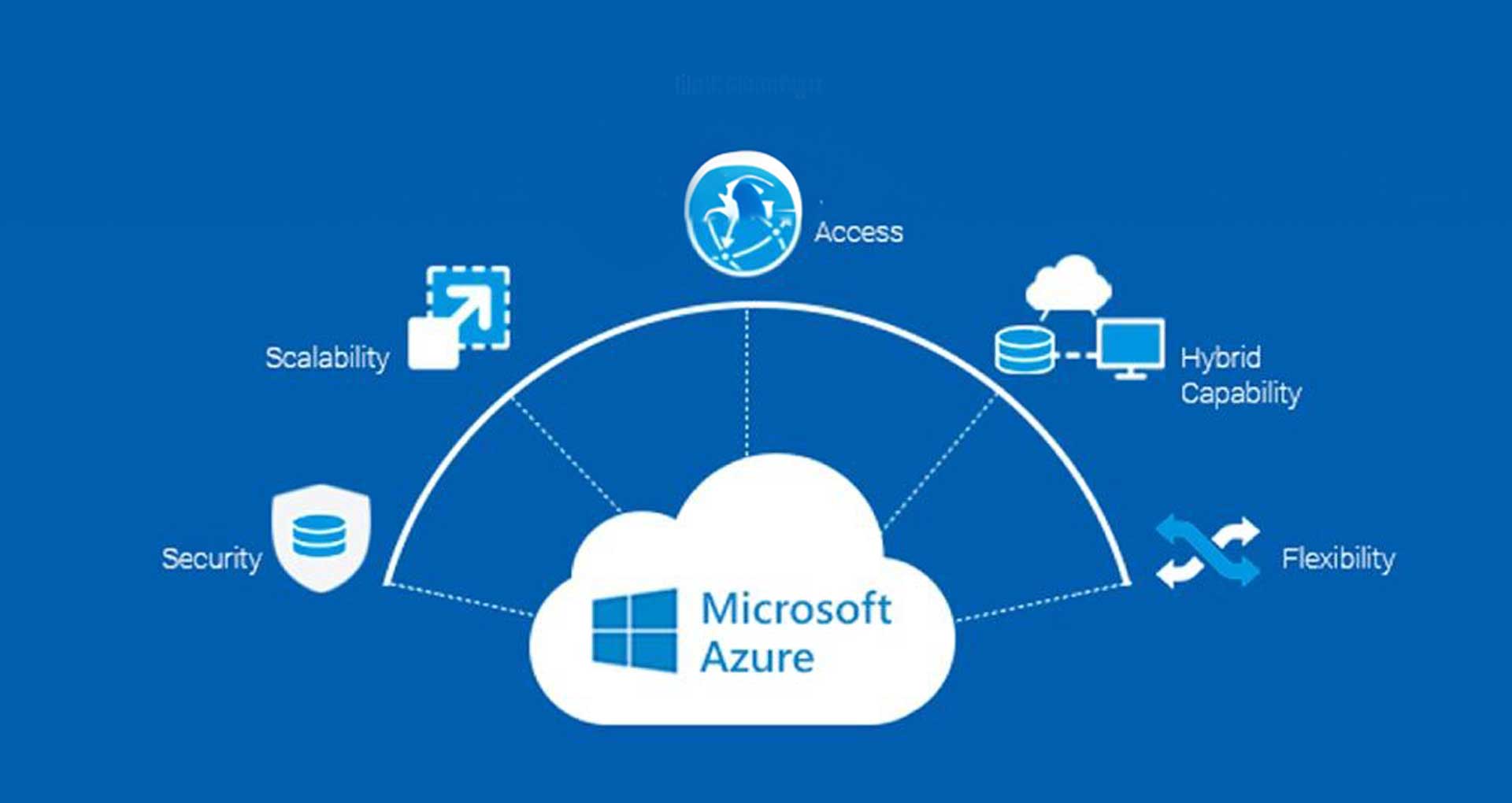
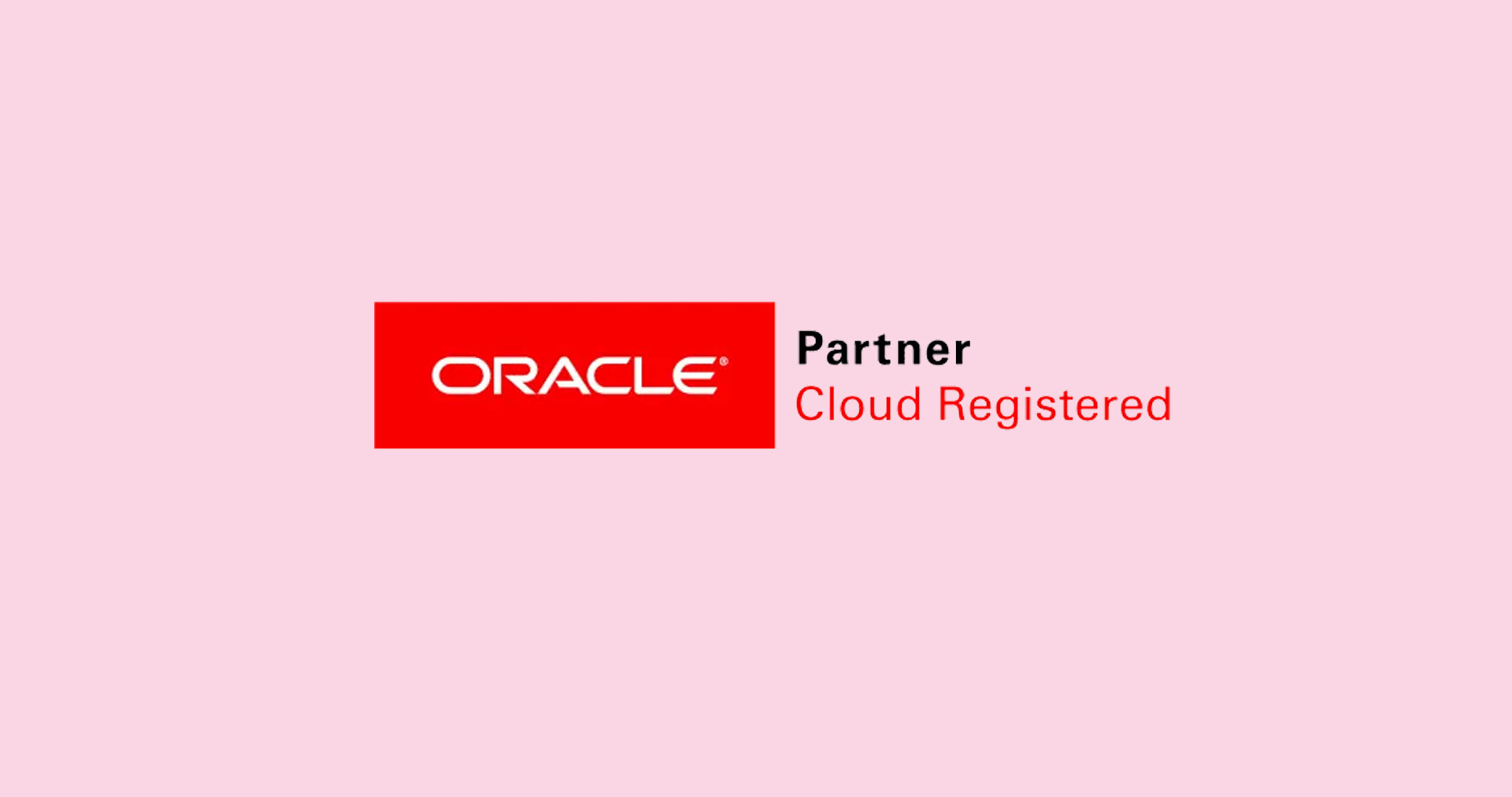






 30 Min
30 Min


